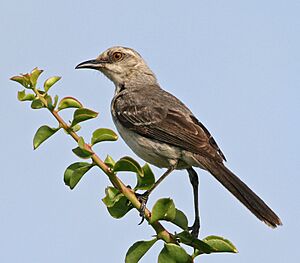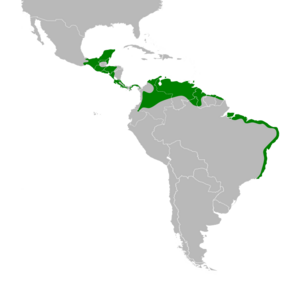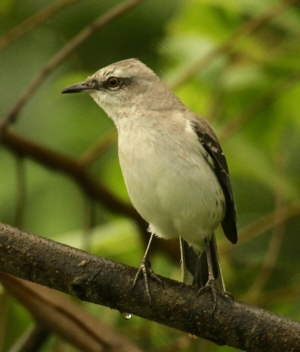Tropical mockingbird facts for kids
Quick facts for kids Tropical mockingbird |
|
|---|---|
 |
|
| Conservation status | |
| Scientific classification | |
| Genus: |
Mimus
|
| Species: |
gilvus
|
 |
|
The tropical mockingbird (Mimus gilvus) is a type of bird that lives in many warm places. You can find it from southern Mexico all the way to northern and eastern South America. It also lives on islands in the Lesser Antilles and other Caribbean areas. These birds stay in the same place all year round; they don't migrate.
Contents
About the Tropical Mockingbird
Sometimes, people thought the tropical mockingbird was the same as its close relative, the northern mockingbird. These two birds are very similar. Another bird, the Socorro mockingbird, is also closely related. It is in danger of disappearing forever.
There are ten different types, or subspecies, of the tropical mockingbird:
- M. g. gracilis
- M. g. leucophaeus
- M. g. antillarum
- M. g. tobagensis
- M. g. rostratus
- M. g. melanopterus
- M. g. gilvus
- M. g. tolimensis
- M. g. antelius
- M. g. magnirostris
Some people thought that M. g. antelius and M. g. magnirostris might be separate species. However, there isn't strong proof from how they look or sound to say they are different species.
What Tropical Mockingbirds Look Like
Adult tropical mockingbirds are about 23 to 25.5 centimeters (9 to 10 inches) long. Their weight can be different depending on the specific type of mockingbird.
Most adult tropical mockingbirds have a gray head and back. They have a white stripe above their eye and a dark stripe through their eye. Their belly is off-white. Their wings are dark, almost black, with two white stripes and white edges on the flight feathers. They have a long, dark tail with white tips on the feathers. Their beak is thin and black, curving slightly downwards. They also have long, dark legs.
Young tropical mockingbirds are a bit browner. They have dark streaks on their chest and sides. Different types of tropical mockingbirds can vary in size. Their wings and tails might be different lengths. Their colors can also be lighter or darker. Some have more pale markings, and their eye color can change. For example, M. g. magnirostris is the biggest type. It also has a much heavier beak than the others.
Where Tropical Mockingbirds Live
The different types of tropical mockingbirds live in specific areas:
- M. g. gracilis lives from southern Mexico down to Honduras and El Salvador.
- M. g. leucophaeus is found in the Yucatán Peninsula and on islands like Cozumel.
- M. g. antillarum lives in the Lesser Antilles, starting from Antigua.
- M. g. tobagensis is found in Trinidad and Tobago.
- M. g. rostratus lives on southern Caribbean islands, from Aruba to Blanquilla.
- M. g. melanopterus is in northern and northeastern Colombia, Venezuela, Guyana, and Brazil's Roraima state.
- M. g. gilvus lives in Suriname and French Guiana.
- M. g. tolimensis is found in western and central Colombia, south to northern Ecuador. It also lives from El Salvador to Panama.
- M. g. antelius lives along the coast of northeastern and eastern Brazil, down to the Rio de Janeiro state.
- M. g. magnirostris lives on San Andrés Island, which is off the coast of eastern Nicaragua.
Some of the M. g. tolimensis birds in El Salvador, Nicaragua, Costa Rica, and Panama came from pet birds that escaped from cages. These birds were originally brought from Colombia.
Tropical mockingbirds are common in many open areas. This includes places where people live, like scrublands, savannas, parks, and farms. They usually stay away from thick forests and mangrove swamps. They live in low to middle elevations. In Central America and the northern Andes, they can be found up to about 2,500 meters (8,200 feet) high. In Colombia, they have been seen as high as 2,600 meters (8,500 feet). In northern Ecuador, they can be found at 3,100 meters (10,200 feet).
Tropical Mockingbird Behavior
What They Eat
Tropical mockingbirds look for food on the ground or in low plants. They also catch flying insects, like swarms of termites, while in the air. They eat many different things. Their diet includes insects like spiders, grasshoppers, and beetles. They also eat seeds, small fruits, berries, and larger fruits like mangoes. Sometimes, they eat lizards, bird eggs, and lizard eggs. They will also eat food from bird feeders and even human food.
Reproduction and Life Cycle
Tropical mockingbirds usually build nests from the end of the wet season into the beginning of the next wet season. During this long time, a pair of birds can have three groups of babies. They usually have one mate for life. Sometimes, older young birds from a previous group will help their parents raise the new babies.
These birds are very protective of their home area. They will bravely defend it against other birds and animals that might be a danger. Both the male and female birds build the nest. They use rough twigs and line the nest with softer materials. Nests are usually placed low in a bush or tree. A female bird lays two to four eggs, but usually three. The female bird does most of the sitting on the eggs for 13 to 15 days. Both parents, and sometimes the helpers, feed the chicks in the nest for up to 19 days. They continue to feed them even after the young birds leave the nest.
How They Sing
The tropical mockingbird's song is very varied and long. It has many different notes, from soft to harsh, and trills. They often repeat parts of their song. These birds will often sing all through the night. They don't seem to copy the songs of other bird species very often. Their calls include a clear "pree-ew" and a harsh "chick" or "chek."
How Many Tropical Mockingbirds There Are
The IUCN (a group that checks on animals) says that the tropical mockingbird is a species of "Least Concern." This means there are plenty of them, and they are not in danger right now. They are "common and easy to see" almost everywhere they live. In some places, like the Lesser Antilles, they have spread to new areas. However, in southeastern Brazil, their numbers have gone down. This is because their homes are being destroyed, and people are illegally catching them.



